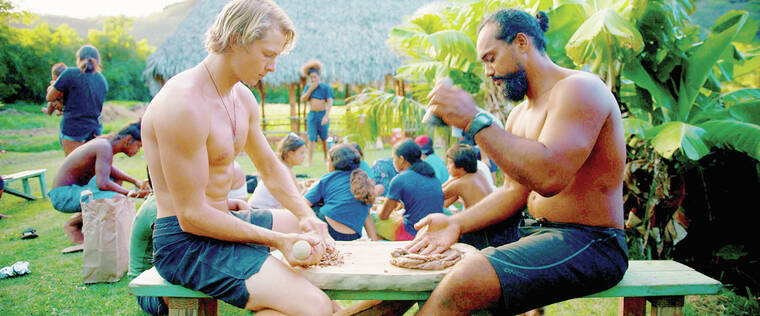In November, local filmmaker Sam Potter, known as Captain Potter on social media, released a new short film, “Aloha ‘Aina – Indigenous Life in Hawai‘i.”
The film has since gained over 80,000 views.
The film chronicles the work of Kaina Makua, who runs Kumano I Ke Ala, a Waimea-based nonprofit that provides cultural, land-based education to at-risk native youth.
In the film, Makua’s students teach Potter the basics of paddling an outrigger canoe, harvesting taro and engaging in cultural lessons.
The film highlights some of Kaua‘i’s sights and sounds, integrating ‘olelo Hawai‘i (Hawaiian language) throughout the film.
For Makua, sharing his story is part of what it means to be Hawaiian.
“Storytelling is the heart of Hawai‘i and the history of Hawaiians,” said Makua. “(‘Olelo Hawai‘i) was an unwritten language. Everything was storytelling.”
After the film debuted, Makua saw a change in his students.
“Now they take ownership of (their stories). Now they can realize it and they see the importance of what we’ve been trying to teach them all these years,” Makua said.
Makua attributes the nonprofit’s growth to the foundation his students laid over the last seven years and the stories they have told, including the stories told in “Aloha ‘Aina.” This winter break, Makua estimates that between 35 and 40 kids are participating in programing, a boost from past years.
In the film’s opening, Potter says, “even though this is my home, I will always be a guest here.”
While Potter hosts the film, he maintains his perspective as visitor who was invited to witness and partake in Hawai‘i’s deeply rooted traditions. The film’s central themes include connecting with the land.
For Potter, who grew up in Koloa, doing a film so close to home carried extra pressure.
“I actually get nervous when I’m taking on a film (on Kaua‘i). There’s a whole other pressure mostly just because it’s home. I have my community to answer to if I don’t do a piece justice,” he said.
Potter had waited to take on this story until he felt like his filmmaking abilities were strong enough to properly tell the stories of his Kaua‘i neighbors.
Potter, 25, started making films with his phone when he was a student at Kaua‘i High School. When he graduated, he bought a GoPro and began making small videos for local companies. His filmmaking abilities and his business have grown from there to where he finally felt ready to take on this film.
“There’s definitely a much-larger kuleana (responsibility) when you want to tell a story right here at home. Because it’s my home, but also because we have a very-complex history, and it needs to be balanced. You need to watch what you say and make sure you really have an understanding of what you’re talking about,” Potter said.
Potter spent weeks volunteering and spending time with Makua at Kumano I Ke Ala before he started filming.
People from all over the world are responding to the film.
“It has something to offer for everyone, from Native Hawaiians to visitors,” Potter said. “I have had people from all over the world — Nepal, Norway, India, Germany, reaching out and leaving comments.”
“Aloha ‘Aina – Indigenous Life in Hawai‘i” can be viewed on YouTube, and is the first episode of a video series called “Back to the Wild.”
•••
Laurel Smith, staff writer and photographer, can be reached at 245-0424 or lsmith@thegardenisland.com.


